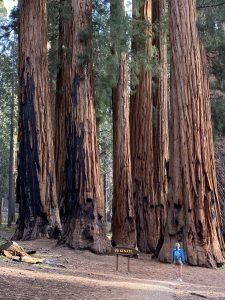 California is one of those ‘dream holiday’ destinations for a lot of people in Europe. However, we noticed that a lot people, traveling the Pan American Highway either skip California or really quickly drive through it to other American States or to Mexico. We also considered skipping the state but in the end we didn’t and we are happy we didn’t. We would have missed some amazing nature, wildlife and Caro would not have had that chat with that celebrity rock singer. But it is true that travelling in a van in California comes with some challenges.
California is one of those ‘dream holiday’ destinations for a lot of people in Europe. However, we noticed that a lot people, traveling the Pan American Highway either skip California or really quickly drive through it to other American States or to Mexico. We also considered skipping the state but in the end we didn’t and we are happy we didn’t. We would have missed some amazing nature, wildlife and Caro would not have had that chat with that celebrity rock singer. But it is true that travelling in a van in California comes with some challenges.
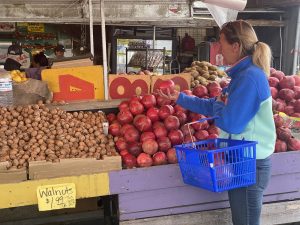 California is the agricultural/technological beating heart of the USA and one of its richest states. This has a couple of consequences for travelers. The first is that the cost of living is very high. Groceries, fuel and campsites are a lot more expensive than other states. But that was also the case in Alaska.
California is the agricultural/technological beating heart of the USA and one of its richest states. This has a couple of consequences for travelers. The first is that the cost of living is very high. Groceries, fuel and campsites are a lot more expensive than other states. But that was also the case in Alaska.
The big difference with Alaska however, and the second reason that makes travelling here harder, is that there is almost no public land. California is densely populated with a lot of cities (it’s the promised land where everyone wants to work and live). And agriculture takes up most of the land outside of the cities. So unlike the other states, there is hardly any land to camp for free.
On top of that there is a big ‘homeless people’ issue in California. A lot of them actually have (several) minimum wage jobs and they live in their cars or vans. This has resulted in all kind of parking lots (eg supermarkets) filled with vans and cars of people who live their ‘permanently’. That is not appreciated by the owners of these parking lots. So they hire security to chase everyone away around 10 pm.
So, really expensive official campsites, no public land to camp for free and interdictions to sleep on parking lots, makes finding a spot to sleep for the night pretty tricky and very time consuming.
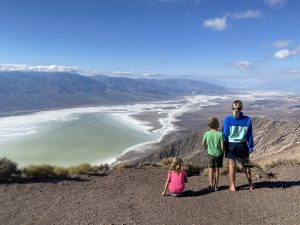 The first place we visited after crossing the Nevada border was the amazing Death Valley National Park. For months it looked like we would have to skip this park. A huge summer storm passed in August with lots of rain. In a couple of hours there was more rainfall than usually in a whole year. Land slides wiped out nearly all the roads in the park. The park was closed completely to the public. But the National Parks service did an amazing reconstruction job and by end of October, a couple of weeks before we got there, the park was partially re-opened and we were able to visit most of the highlights of the park. Being in Death Valley in November has the big advantage that temperatures are bearable. Due to the low altitude, the desert near Bad Water is one of the hottest places on Earth. In summer temperatures go above 50 degrees. While we were there it was a comfortable 25 degrees. And the August storm had had a nice side effect. A lake in the Badwater valley that had disappeared a long time ago had reappeared.
The first place we visited after crossing the Nevada border was the amazing Death Valley National Park. For months it looked like we would have to skip this park. A huge summer storm passed in August with lots of rain. In a couple of hours there was more rainfall than usually in a whole year. Land slides wiped out nearly all the roads in the park. The park was closed completely to the public. But the National Parks service did an amazing reconstruction job and by end of October, a couple of weeks before we got there, the park was partially re-opened and we were able to visit most of the highlights of the park. Being in Death Valley in November has the big advantage that temperatures are bearable. Due to the low altitude, the desert near Bad Water is one of the hottest places on Earth. In summer temperatures go above 50 degrees. While we were there it was a comfortable 25 degrees. And the August storm had had a nice side effect. A lake in the Badwater valley that had disappeared a long time ago had reappeared.
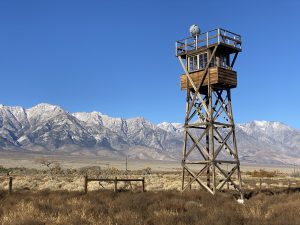 At the same time in the next park that we were planning to visit, Sequoia NP, a first winter storm was dropping a lot of snow on the mountains and temperatures were -15. Since we don’t carry snow chains, we decided to stick around Death Valley a bit longer and we also added a detour to a historical site with a very dark piece of US history. Manzanar was a ‘concentration camp’ where during World War II, the US Government imprisoned all persons of Japanese descent living on the West Coast. Most of them stayed imprisoned until the Japanese capitulation. We found it very sobering how a mix of fear, hate speech and ‘fake news’ (it’s not something new!) could lead the US president and Congress to approve such measure against its own (long time) citizens.
At the same time in the next park that we were planning to visit, Sequoia NP, a first winter storm was dropping a lot of snow on the mountains and temperatures were -15. Since we don’t carry snow chains, we decided to stick around Death Valley a bit longer and we also added a detour to a historical site with a very dark piece of US history. Manzanar was a ‘concentration camp’ where during World War II, the US Government imprisoned all persons of Japanese descent living on the West Coast. Most of them stayed imprisoned until the Japanese capitulation. We found it very sobering how a mix of fear, hate speech and ‘fake news’ (it’s not something new!) could lead the US president and Congress to approve such measure against its own (long time) citizens.
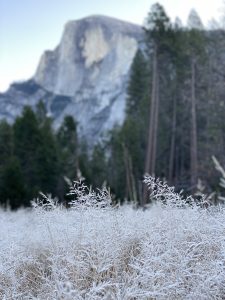 In the meantime the storm in the Sierra Nevada had passed and most of the snow was molten. We were walking around in shorts and T shirts where there had been 1.5 m of snow just a couple of days earlier. Sequoia and King’s Canyon National Parks are home to the ‘biggest’ (‘in volume’) trees in the world. These giants are often 2000 to 3000 years old and are super impressive. We did several hikes between these giants and had planned a couple more. However, when we went to the visitor center for the kids’Junior Ranger Program’ and we discussed our next steps with the ranger and she had a surprise for us. She warned us that the next park on our list (Yosemite) would be incredibly busy due to the Thanksgiving weekend. We had Thanksgiving on our radar, but thought that Thanksgiving was THE time that Americans spent time at home with family, before shopping till they dropped the next day on ‘Black Friday’. We thought we would have the place to ourselves. WRONG! Apparently since a couple of years a ‘counter-Black Friday’ movement has appeared and the thing they like most is to be away from the cities during this weekend.
In the meantime the storm in the Sierra Nevada had passed and most of the snow was molten. We were walking around in shorts and T shirts where there had been 1.5 m of snow just a couple of days earlier. Sequoia and King’s Canyon National Parks are home to the ‘biggest’ (‘in volume’) trees in the world. These giants are often 2000 to 3000 years old and are super impressive. We did several hikes between these giants and had planned a couple more. However, when we went to the visitor center for the kids’Junior Ranger Program’ and we discussed our next steps with the ranger and she had a surprise for us. She warned us that the next park on our list (Yosemite) would be incredibly busy due to the Thanksgiving weekend. We had Thanksgiving on our radar, but thought that Thanksgiving was THE time that Americans spent time at home with family, before shopping till they dropped the next day on ‘Black Friday’. We thought we would have the place to ourselves. WRONG! Apparently since a couple of years a ‘counter-Black Friday’ movement has appeared and the thing they like most is to be away from the cities during this weekend.
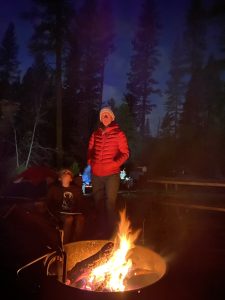 With this news we quickly looked at the map and decided to drive asap to Yosemite and try to grab a camping spot in the park before the weekend really started. We got lucky and got a spot. It was away from the main attractions of ‘the valley’ but we had a really nice time relaxing and learned all about the Thanksgiving traditions and the different sentiments people across the US have about this feast.
With this news we quickly looked at the map and decided to drive asap to Yosemite and try to grab a camping spot in the park before the weekend really started. We got lucky and got a spot. It was away from the main attractions of ‘the valley’ but we had a really nice time relaxing and learned all about the Thanksgiving traditions and the different sentiments people across the US have about this feast.
 On Black Friday we did what our local friends had advised: drive into the valley as early as possible to find a parking spot, hop on a shuttle bus and hike away from the crowds. When we arrived the sun was just rising and the impressive mountains were still veiled with clouds. We found a parking spot easily and then hopped on the bus to the trailhead. We did a really beautiful longer hike to Vernal and Nevada Falls. There were some people on the trail but it was not busy at all. We started to think that maybe the ranger In Seqoia NP had exaggerated a bit…Until we got back to the start of the trail (where there is also a short hike) and all of a sudden were crowds that felt like you were walking out of a festival just after the last band finished. With some delay (full buses and traffic jams) we got back to our parking spot and decided to sleep there (illegally) in the van.
On Black Friday we did what our local friends had advised: drive into the valley as early as possible to find a parking spot, hop on a shuttle bus and hike away from the crowds. When we arrived the sun was just rising and the impressive mountains were still veiled with clouds. We found a parking spot easily and then hopped on the bus to the trailhead. We did a really beautiful longer hike to Vernal and Nevada Falls. There were some people on the trail but it was not busy at all. We started to think that maybe the ranger In Seqoia NP had exaggerated a bit…Until we got back to the start of the trail (where there is also a short hike) and all of a sudden were crowds that felt like you were walking out of a festival just after the last band finished. With some delay (full buses and traffic jams) we got back to our parking spot and decided to sleep there (illegally) in the van.
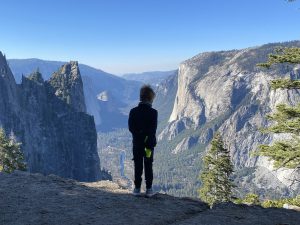 The next day we repeated the same process and we found the perfect hike for that. We had been wanting to go to Glacier Point but due to the storm, the road to get there was already closed for winter. The good news was that the trail was still open. It was a tough hike (15km and 1000 m elevation) but it was not boring for a second as there were views over the whole ‘Valley’ and the views at Glacier point were even better.
The next day we repeated the same process and we found the perfect hike for that. We had been wanting to go to Glacier Point but due to the storm, the road to get there was already closed for winter. The good news was that the trail was still open. It was a tough hike (15km and 1000 m elevation) but it was not boring for a second as there were views over the whole ‘Valley’ and the views at Glacier point were even better.
We had a fun moment at the top when we witnessed how a marriage proposal works these days. The magic moment needs to be shared on social media so the happy couple is preferable in a very spectacular environment…and they need a camera man/photographer. In our case it took three takes with three different photographers (Caro was one of them) and each time the same ‘scene’ was played (he’s getting on his knees and she is all ‘Oh my god, oh my god’). After the first take they were already fighting (“It’s not because you like this view that I have to like it”, “This angle makes me look too small).
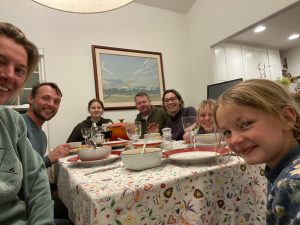 We wished the good luck with the marriage and started descending in to the valley where we would sleep one more night and then after a morning walk we were heading to the coast and the city of San Francisco. But first, we went to visit a former colleague who has been living and working her with her family for almost 10 years. They sure had some interesting and shocking stories to tell about their life in one of the most expensive places in the world. Not being fans of driving in cities, we took the train to San Francisco for a wander around. Seeing all the super steep streets, we were happy not to be driving.
We wished the good luck with the marriage and started descending in to the valley where we would sleep one more night and then after a morning walk we were heading to the coast and the city of San Francisco. But first, we went to visit a former colleague who has been living and working her with her family for almost 10 years. They sure had some interesting and shocking stories to tell about their life in one of the most expensive places in the world. Not being fans of driving in cities, we took the train to San Francisco for a wander around. Seeing all the super steep streets, we were happy not to be driving.
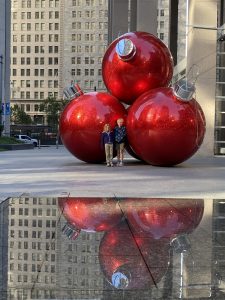 Although there are some really nice things to see and do north of SF, we decided to not drive further up the coast this time. We only had about 3 weeks left on our campervan insurance and would need to be in Mexico before it expired. So from now on, it’s south towards Mexico…but with some nice stops of course.
Although there are some really nice things to see and do north of SF, we decided to not drive further up the coast this time. We only had about 3 weeks left on our campervan insurance and would need to be in Mexico before it expired. So from now on, it’s south towards Mexico…but with some nice stops of course.

Prachtig allemaal!♥️
fantastisch!!